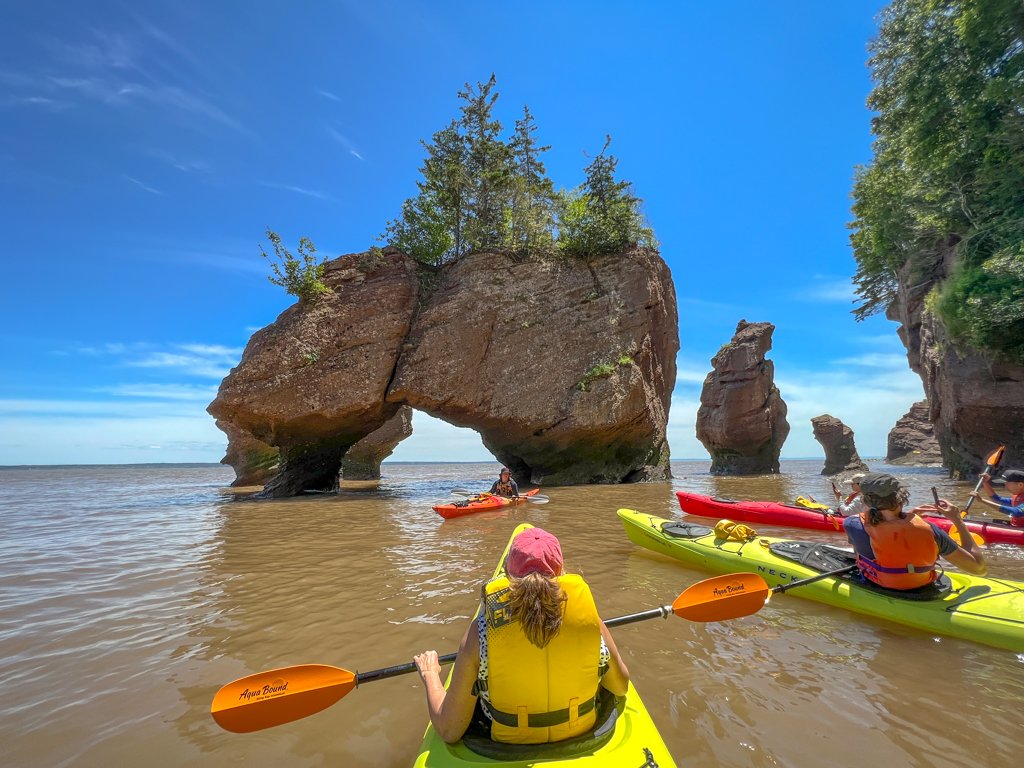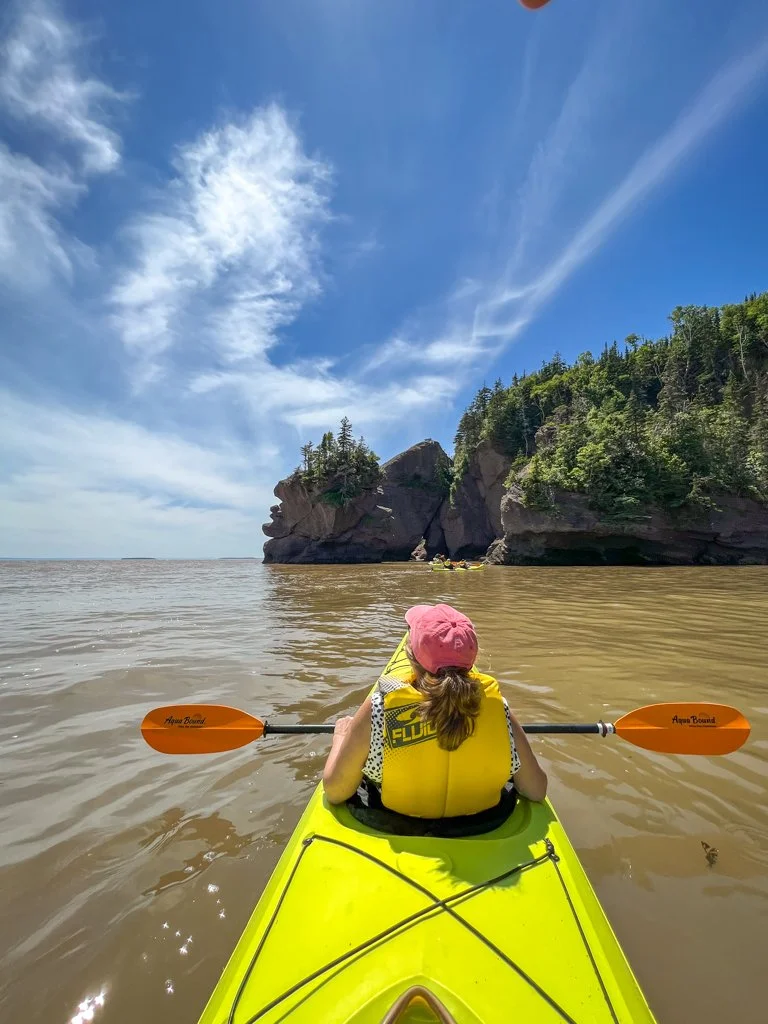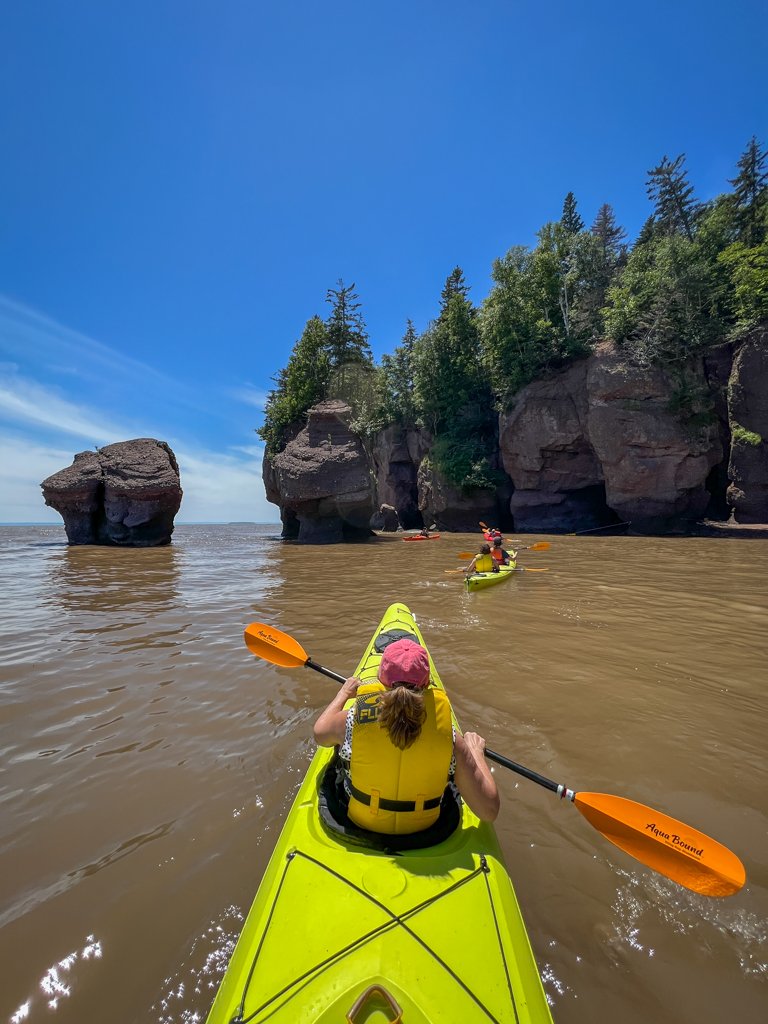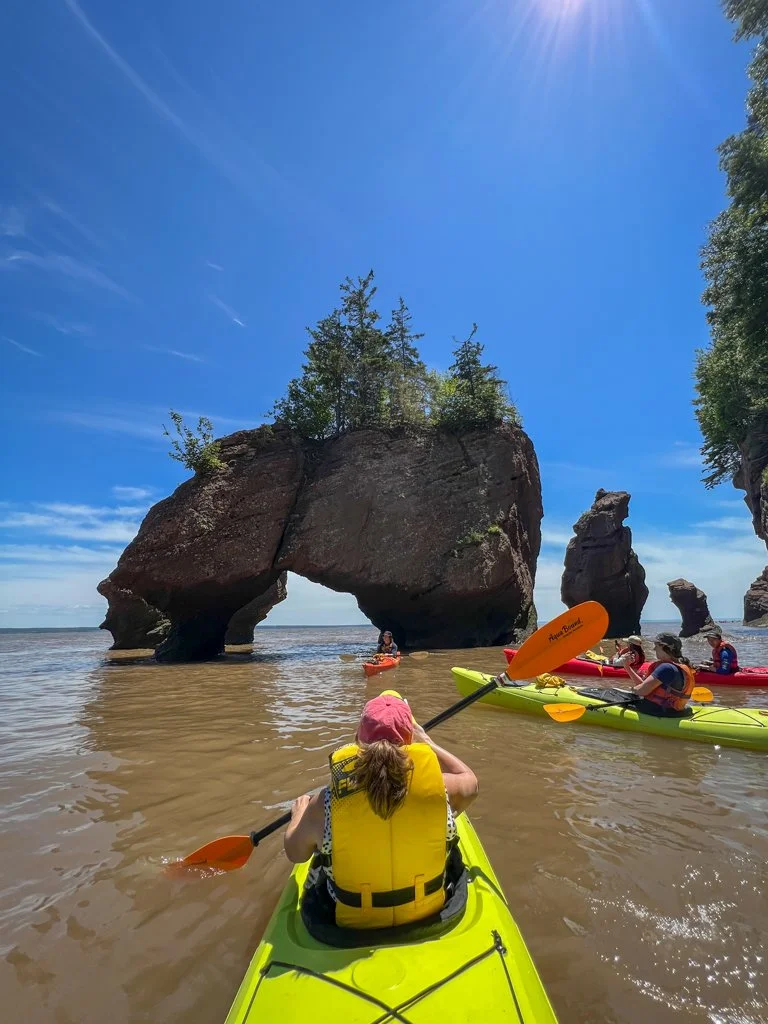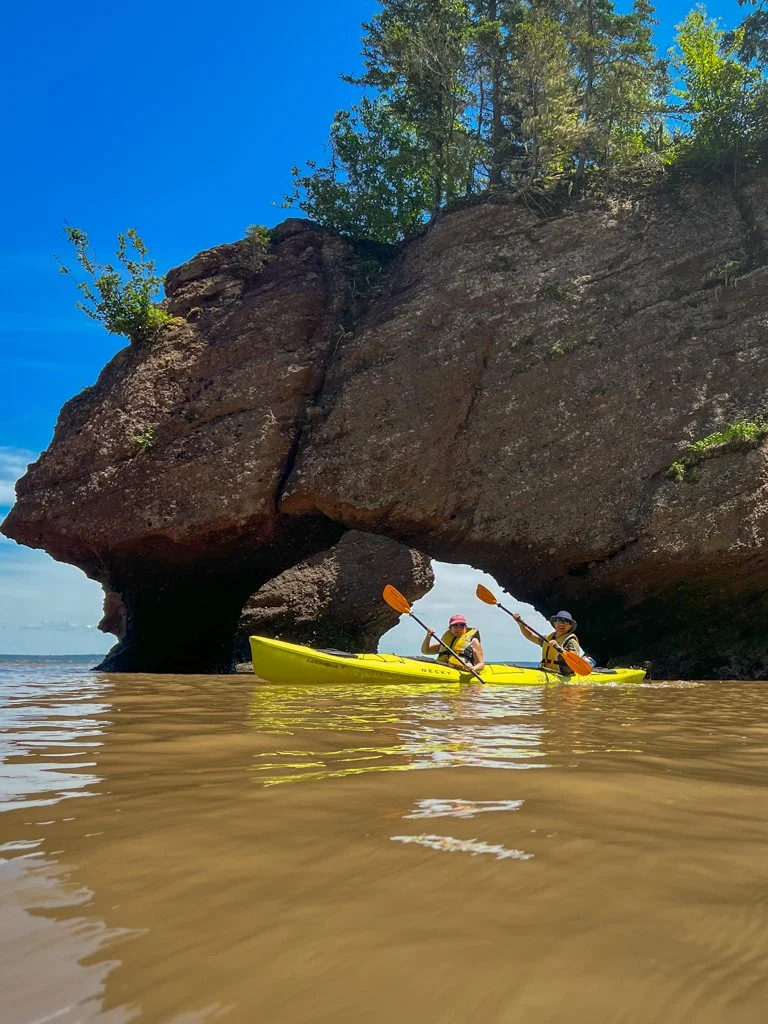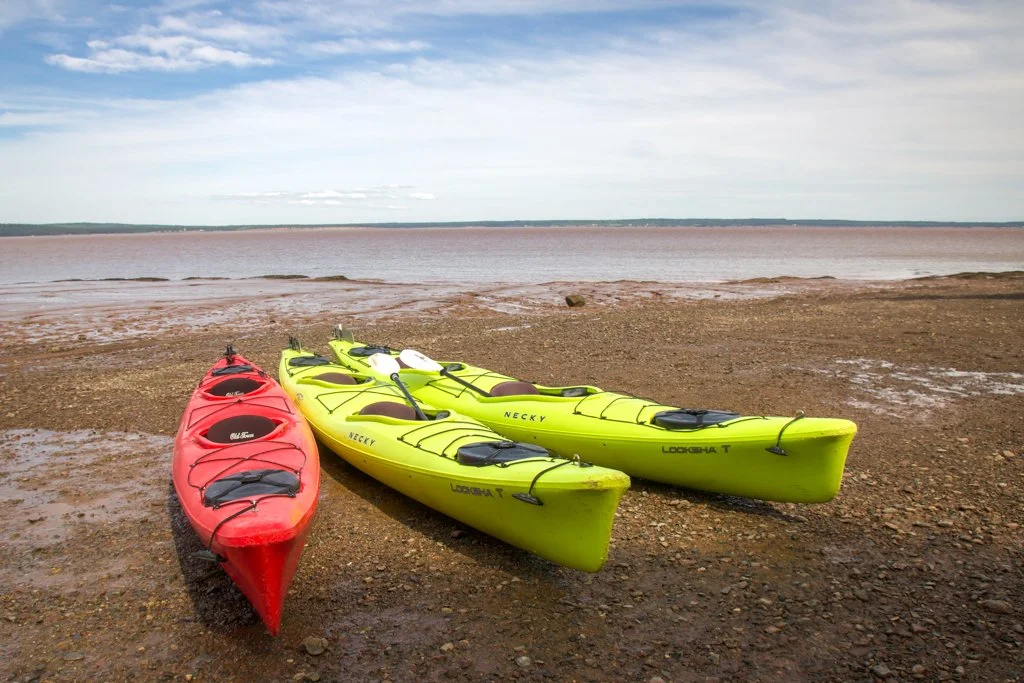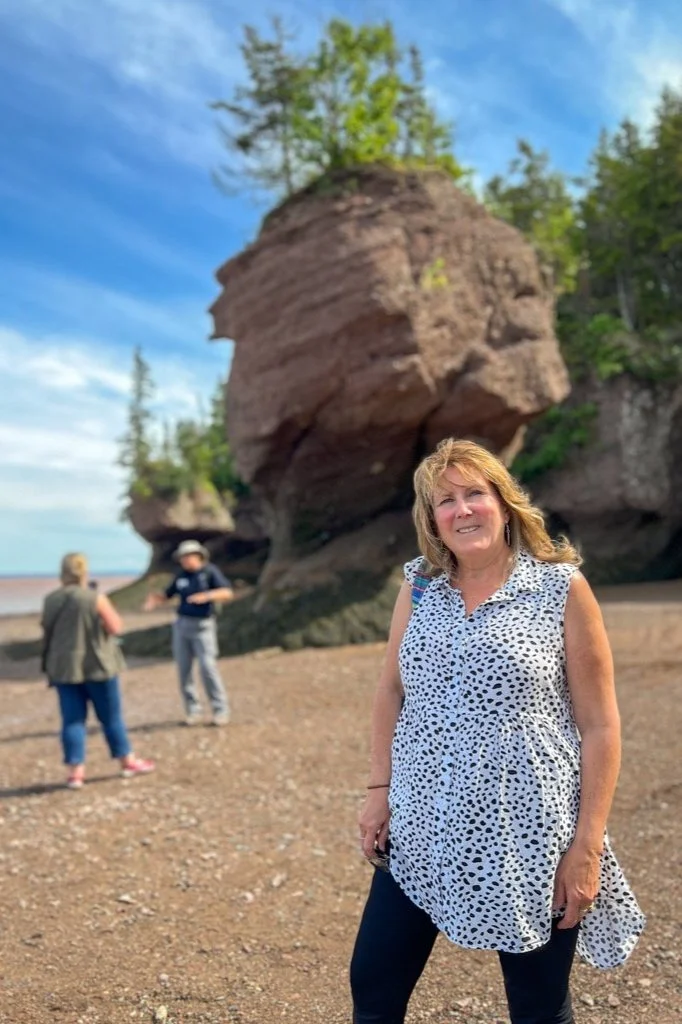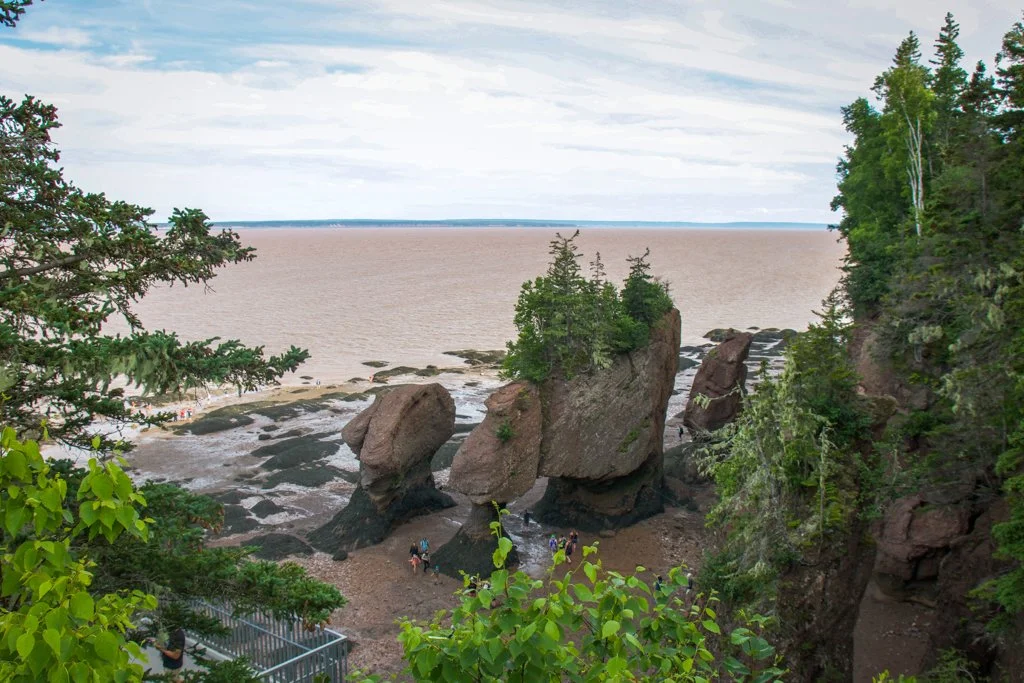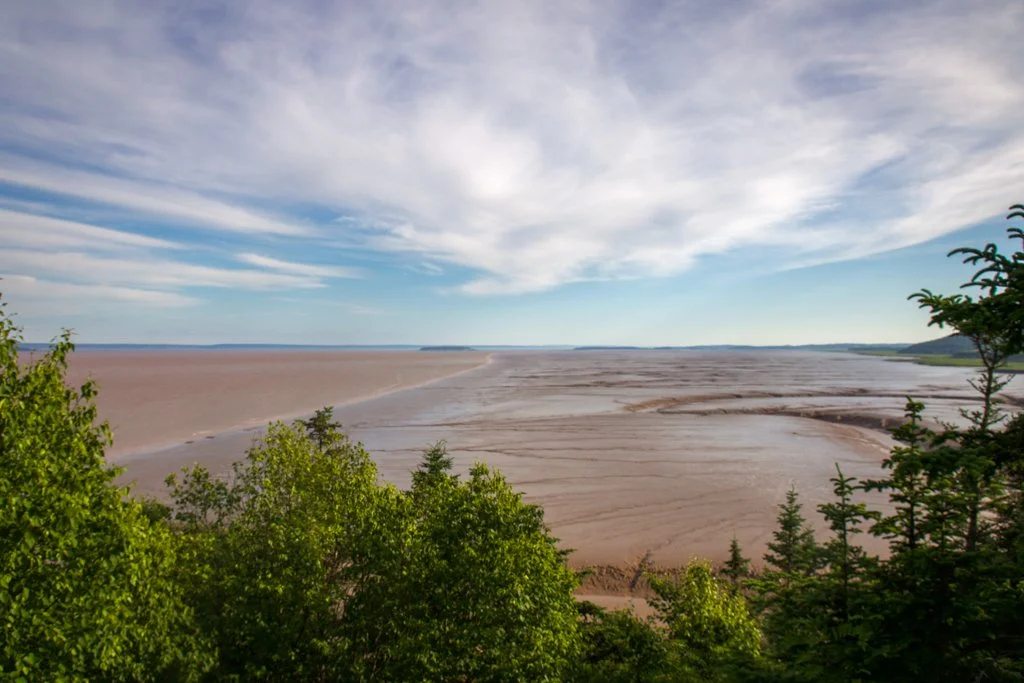Kayak the Rocks and Walk on the Ocean Floor at Hopewell Rocks
Highest Tidal Paddling Experience on Earth
To kayak amongst the Hopewell Cape flowerpot rocks at high tide is to enjoy the highest tidal paddling experience on earth. To walk on the ocean floor around these same sea stacks at low tide is a unique opportunity that is not to be missed when in New Brunswick. Doing both of these Bay of Fundy UNESCO World Heritage Site activities back-to-back is to fully appreciate the awesome natural wonder of the highest tides in the world.
Kayak the Rocks
Let me begin by saying, I am a novice kayaker and I absolutely loved this “Kayak the Rocks” adventure. Like any beginner though, I had some concerns when I first saw this outing on my New Brunswick Tourism itinerary. “Will I be able to handle a sea kayak?, Will it capsize?, Will I be safe?” I wondered. However, all my fears were put to rest by the Baymount Outdoor Adventures team as they thoroughly educated & prepared our group, answering any and all questions. I took a breath and realized, it would be fine. Worst case scenario - I might get wet. Dry bags were available for cameras and phones but I decided to forego that and just focus on keeping upright & paddling. Besides, my partner Will assured me that he would capture our day’s fun with his iPhone camera.
We signed waivers, locked up items we didn’t want to bring with us, and were fitted with life jackets. Then an on-land safety briefing was provided to our larger kayaking group - an opportunity to get familiar with the various paddling strokes. It was followed by a walk to the beach with a few more additional safety instructions given at the launching point as we settled into our kayaks. Baymount’s staff made sure everyone was comfortable and knew how to manage their own safety before each team took to the water.
All guests use Baymount’s double kayaks and their equipment. You cannot bring your own kayak or gear. They know and inspect their equipment daily and it is for this reason you use theirs. Know that you are in good hands with Baymount’s experienced team. I asked & learned that capsizes do occur, but in the event of one, guides are extremely well-trained to implement a quick, efficient rescue. I felt very safe & comfortable. It didn’t hurt that my kayak partner Will Tang (goingawesomeplaces.com) was an experienced kayaker, but I watched plenty of beginners like me, and they did just fine too.
Take a peek at the credentials on Baymount’s website. The owner Shaun Gibbs brings “20+ years of sea kayaking skills, leadership and customer service experience with him. Since 2007 he has also been a lead guide for Coastal Adventures Inc, and a Paddle Canada sea kayak skills instructor.” Shaun & his wife Ashley selected their talented skillful staff to ensure a safe and high-quality experience for guests. Many guides are fluently bilingual too. If you require a French guide, just indicate so when making your online reservation.
Hopewell Rocks Park
Book ahead and plan to arrive at the park an hour early. The Hopewell Rocks Park is owned & operated by the Provincial Department of Tourism & Parks and visitors must pay a park admission fee. Check their website for current rates. Your park pass is good for two days which is great for ensuring additional time to walk the ocean floor. It takes 10-15 mins to walk down to Baymount’s office from the main gate so keep an eye on the time. You need to be at Baymount’s office at least 30 minutes before your tour begins. Bring your hat, sunglasses, sunscreen, and water. Baymount’s website also suggests a lightweight nylon coat, and a change of clothing as well. Most Kayak the Rocks participants wore t-shirts & shorts and beach footwear. Our crew wore sneakers and I saw watershoes on others. Chances are pretty good that you will get wet and/or muddy so plan accordingly.
High Tide Tour
We twisted & turned in and around the flowerpot rocks for nearly 2 hours covering approximately 4 km. There is nothing like it! Baymount ‘s website states that…“From a scenery perspective, the experience is essentially the same on all high tide tours.” The first two tours go out on a rising tide, while the 3rd & 4th tours paddle a falling tide.” My advice is to listen to your guide, follow their instructions, and enjoy the experience. Our guide Alec Lepage was very attentive to everyone’s needs - giving tips & recommendations to aid in maneuvering through tunnels & narrow passageways. He also drew attention to key landmarks and shared interesting facts along the way making the tour very entertaining. Thanks to Alec and my kayak partner Will, I also have some wonderful photographic memories of the day.
All in all, we had a stellar day! Couldn’t be much better we were told. The sun was shining and the wind was low. Apparently, wind, waves and the tide direction may make the paddling conditions different from one tour to the next. For this reason, tours are not suitable for children under 10 and youth 10-18 must be accompanied by an adult. No pets are allowed.
Mid-Tide Tour
Baymount’s website describes their coastal mid-tide tour as “a 1.5 hour paddle that provides guests with a unique panoramic view of the flowerpot rocks just as the tides are receding and revealing the true identity of the rock formations. Guests also have a special opportunity to navigate through the Ledges and up the mud-lined Demoiselle Creek at the south end of the park.” When fully exposed the massive 4 km mudflats at the foot of Shepody Mountain serve as a stark contrast to the flooded bay you kayak on.
Canadian Tourism Signature Experience
Baymount’s Kayak the Rocks tours “have been recognized for their outstanding quality and are recipients of the New Brunswick “Savvy Traveller” Award and “The Bay of Fundy Recommended Experience” Award. In 2012 the Kayak The Rocks Tour became a part of the Canadian Tourism Commissions "Signature Experience Collection" that is used to promote Canada in the international marketplace.” I am not surprised by these accolades as this is a world-class experience. Don’t miss it. I don’t know why I waited so long to do the first time. I cannot wait to do it again.
Hopewell Rocks After Dark
Check out the Hopewell Rocks After Dark tour too. This unique 2-hour tour begins at dusk. Kayaks are fully equipped with headlamps & glowsticks and guides lead you on a truly memorable nighttime adventure.
Baymount Outdoor Adventures are Making a Difference
Know that you are supporting a business that gives back when you book a tour with Baymount Outdoor Adventures. The staff donates $2000 each year from their gratuities (matched by the owners), to support outdoor education for local schools & youth groups. If you enjoy your Kayak the Rocks experience, consider leaving a tip and helping Baymount pay it forward.
Walk on the Ocean Floor
You can access the beach and walk on the ocean floor at Hopewell Rocks three hours before low tide until three hours after low tide. Visit the Hopewell Rocks Provincial Park website for daily low tide times. Guests are free to explore the beach on their own or to join a Park Interpreter. Sturdy footwear is recommended. Guided tours are free and are advertised daily on the Park’s bulletin board. A Low Tide (walk the beach) Tour and a High Tide (walk the trail & view points) Tour are each offered once a day.
Explore the Shoreline at Low Tide
Climb down the large staircase at the main deck near the Interpretive Centre or descend the ramp at the park’s North Beach to explore the shoreline at low tide. Although the ramp is suitable for wheelchairs, the ocean floor is not. We were told the ocean floor is just too challenging for wheels. Heather Allen, our Park Intrepreter recommended we begin our tour at the ramp and walk to Diamond Cove then climb the 101 steps back up to the Interpretive Centre. So, we began our tour where we first put our kayaks in the water a few hours earlier. It was fascinating to experience it all for a second time from a completely different perspective.
The Ledges
The Park’s website lists a third entrance to the ocean floor via a trail leading south from behind the Interpretive Centre. This access “requires no stairs or ramps as the trail gently descends to sea level.” The website states that “Many use the Ledges as a turnaround point but more adventurous guests may choose to clamber over this outcrop ridge of limestone rock. Caution must be used though as the Ledges are often slippery and can shift underfoot.”
Iconic Flowerpots
The massive tides of the Bay of Fundy have been sculpting the landscape here for thousands of years and they will continue to do so. Seeing these iconic flowerpots up close is an awesome sight. Heather suggested for those doing a self-guided tour to give themselves at least an hour or two to explore the over 20 free-standing sea stacks along a 2 km stretch of shoreline at Hopewell Cape.
Original Rock
“This is Original Rock,” Heather announced to us. “This particular flowerpot (pictured above) is called ‘Original Rock’ because it was the first rock visible at the Park’s visitor entrance years ago. There used to be an old staircase and it would bring you face to face with this flowerpot.” Heather shared that earlier this year the park staff were hearing a rumour had been circulating that this flowerpot had fallen and that Hopewell Rocks was not worth visiting anymore. Well, I am here to tell you, Original Rock is STILL HERE and Hopewell Rocks Provincial Park remains a spectacular tourism destination! I photographed Original Rock and had my friend Will photograph me standing beside it. Heather said all rumours begin somewhere and it was true that something did happen to a flowerpot rock in New Brunswick last winter. However, she emphasized, “It’s not here at all. It is on the Fundy Trail Parkway - almost at St. Martins. They had their own, one small flowerpot, and it did fall over, but it is about a 2 hour drive from here, so all our flowerpots are nicely intact.” Rest assured folks, there are heaps of sea stacks to see at Hopewell Rocks and I highly recommend you come and see Original Rock and the many other free-standing flowerpot rocks for yourself.
Hopewell Cape’s Flowerpots Have Names
Did you know that many of Hopewell Cape’s flowerpots have names? Sea stacks come in a variety of shapes & sizes and if you squint a bit and use your imagination, it doesn’t take long to understand where their titles originate. Look for: Lover’s Arch, Sentinel, Elephant, Bear, Dinosaur, ET, Mother-in-Law and Jay Leno. There are others, but these ones stood out to me. Heather says “Mother-in-Law” is her favourite as everyone gets a good chuckle over it. Mine is “Jay Leno” as the chin is a great resemblance. If you are investigating the beach on a self-guided walk, see if you can find them. There are Interpretive Park Guides on the beach to point them out and answer any questions you may have. Perhaps you can come up with some new names for the unnamed sea stacks too.
Flowerpot Rocks Stand a Long Time
There has been speculation on how long Hopewell Cape’s flowerpots will last but Heather reassured us that measurement forecasting research indicates many of the sea stacks - like this one in the photo above - will last at least another 150 to 170 years from now. Flowerpot rocks stand a long time. So even though the Bay of Fundy tide is always carving out a new landscape at Hopewell Cape, some of the flowerpots you see today could last long enough for your grandchildren’s grandchildren’s grandchildren to see them too.
Seaweed Face Mask Anyone?
At low tide another sight catches guests by surprise - the seaweed that clings to the base of the flowerpot rocks and the cliffside walls. “We have two kinds of seaweed in the park,” Heather told us,“Knotted Wrack & Bladder Wrack (Fucus vesiculosus). Knotted Wrack has interesting air pockets in their stems that helps them float in the water. Bladder Wrack has algin in their pods which is an emulsifier that is used in chocolate milk to keep the chocolate and the milk from separating, and it is in ice cream, in toothpaste, and in makeup products too. This is the one that I like to slather on my face hoping the hydrating properties will reverse some of my sun damage and take 10 years off my age,” she laughed. Seaweed face mask anyone? Keep an eye on Heather’s ever-younger looking face for proof that this Ocean Floor Interpreter’s skin regime is no laughing matter.
6-Minute Rock
Heather pointed out a special rock they use as a measure of safety called 6-Minute Rock.“ It’s a very important rock,” she stated, “And there is a very important job that we do here in the Park, and that is making sure that everybody is where they need to be when the tide starts coming in. This is our lowest elevation on this coastline,” she explained. “When tidal water touches this rock, things start happening. Our three guides - one is at the opening to Diving Cove, one is at the Ledges, and someone is here (at 6-Minute Rock) - so when the water reaches here, we call each other on our radios and announce ‘Water is at 6-Minute Rock.’ What that means - is that it takes just 6 minutes from the time the water touches this rock until it reaches the cliff (she points just a mere 10 feet away). It can take as little as 4 to as much as 10 minutes - depending on the tide of the day. We then stop people from going past, because they literally won’t have time to go in and take a photograph and come back before it is touching the seaweed.” The tide is that fast, so read & heed the park signs and listen to the guides when they advise you where you should be and when it is time to leave the ocean floor as they fully understand the power of the Bay of Fundy tides.
Stranded
In fact, Heather shared that there was a man once who chose to ignore the approaching tide and his wife’s advice who did not trust he would be okay exploring on a bit further up the shoreline. She returned up the staircase and said she would meet him topside. He learned the hard way, that he didn’t have time as he quickly found himself surrounded by water. It was too late for him to head to the staircase and he found himself stranded on the beach needing to find higher ground and fast. “Look for grassy areas,” Heather advised us, if you ever find yourself in his predicament. She pointed to cliff ledges that had grass growing on them. “That’s a sign that the tide doesn’t reach up that far. That’s your only hope unless you are close to the high-water platform.” We learned this shelf was built to serve as a rescue station for anyone who did indeed become trapped on the ocean floor with no escape.
Paul Gaudet, from the Park’s Management Services shared with me later via email that it was him who encountered the wife as she knocked on the door to his office. “This was in late October or early November (we were closed for the season) and I drove her up to an outlook where I hollered down to see if the man was indeed on the escape deck. He contritely answered that he was. I told him that he would have to wait two or three hours and that his wife and I were going to lunch which we did.”
Paul shared a more complicated stranding, again with him involved. “Two women phoned 911 and the RCMP called me to come down, again after we were closed for the season. When I arrived there were two police cars, two ambulances, 4 fire departments and a large cormorant helicopter hovering over the beach. I gave them my opinion where they might be and after some communication problems between the helicopter and the people on the ground the two ladies were rescued by a zodiac. They were plucked from some rocks and then ferried to the beach and were deposited there, unwet and unharmed and highly relieved.” So, read the signs folks, listen to the guides, and do not visit when the park is closed for the season.
Elephant Rock Fell
Hopewell Cape sadly did lose one of their precious flowerpot rocks not too long ago. Heather shared that “Elephant Rock fell in March of 2016. Our Park photographer, Kevin Snair happened to be in the park that day and went to investigate. Half of Elephant Rock’s head had been cleaved off. He took a photograph and posted on it on his social media. He was immediately bombarded by media people asking about our famous Elephant Rock - the one that is on our NB Medicare Health Card. Kevin’s photo even made it to the front page of the New York Times.” This beloved Elephant Rock was first named for its resemblance to a charging elephant. A massive one too as it was 100 feet high & 8 feet wide. The mixture of sandstone & soft conglomerate rock did not have a chance against the Fundy Bay tides though, which rise & fall 36 to 46 feet daily. The Fundy Tide helps create these flowerpots but it also plays a role in their demise too.
Mother Nature is at Work
Mother Nature is continually at work at Hopewell Cape. In spring, when the snow melts, water gets into cracks in the rocks, then the water freezes again when temperatures drop at night. This freeze-thaw-freeze cycle weakens the stone and over time erodes the sea stacks and rock walls along the coastline. Many were gutted when Elephant Rock fell but the very forces of wind, rain, tides and varying temperature that take down these mighty flowerpots are also creating the new flowerpots of tomorrow.
Iconic Flowerpot Rocks
Each spring before any Hopewell Rocks Provincial Park guests can walk on the ocean floor, a dedicated safety team rappels down the cliffs, and with crowbars loosen and remove any rocks that look dangerously close to falling. They inspect each and every free-standing sea stack and cliff face to see what is safe and what is not. Safety perimeters are then set. Yellow tape indicates where visitors can go and cannot go. Great care is taken to ensure guests will have a safe & enjoyable visit at these iconic flowerpot rocks.
Flowerpot Babies
Heather shared that despite losing some flowerpot rocks from time to time, it is exciting to see new flowerpot babies being formed. She pointed to one that all the guides feel will become the next newborn. It is only attached to the cliffside by a small section now (see photo above). “Rain, snow and ice will slowly cut away at the cliff until it is completely separated,” Heather shared. “That one will hopefully separate in the next 5-10 years.” I wonder, does a guide hand out stones in celebration of a newborn flowerpot? I must ask Heather.
Stunning Lookouts and an Interpretive Centre
The park’s website describes their lifeline as a “network of well-groomed, wheelchair-friendly trails.” It boasts “Stunning lookouts, secluded vistas, ocean floor access, and natural forests all just a short walk from the main building. For those who prefer a more direct route to the main attraction, a shuttle service is available (for a nominal fee) to take you from the Interpretive Centre to the top of the stairway that leads to the ocean floor.” Dogs are also welcome but must be on leashes. Spray your muddy shoes at the handy cleaning station after your ocean floor walk before you return to your vehicle and pop into the Interpretive Centre and gift shop. You will find lots of interesting exhibits & displays describing the geology and history behind everything you have just witnessed. I learned that “The Bay of Fundy's geological history dates back 250 million years.“
Shorebirds
To birdwatchers’ delight, shorebirds are present from mid-July to mid-September, with peak numbers occurring in the 2nd & 3rd weeks of August. Large flocks of roosting shorebirds can be viewed two hours on either side of high tide. Heather described the scene,“Our mudflats extend on both sides of our park. Daniels Flats on one side & North Beach on the other. The mud is full of mud shrimp, worms and phytoplankton. By the end of July & August we get the Semipalmated Sandpipers and Plovers coming to our mudflats. Mostly the Sandpipers though. They have nested in the Canadian North and fly here to rest and double their size by eating those delicious mud shrimp. Then they fly to South America when they leave our shores”
Baymount’s website shares that “Spectacular close-up views of large numbers of shorebirds in flight are a special treat reserved for kayakers. In mid-August guests may have the rare opportunity to paddle in the midst of tens of thousands of migratory shorebirds as they whirl & swoop in unison. The experience is world-class but only available in August when the birds stop briefly to feed & refuel for the final leg of their journey to South America.”
Our Ocean Floor Expert Interpreter Heather has been a tour guide for 4 years now. “I retired in May 2019 from my career,” she shared,“and started working at the Rocks in June 2019. It’s true what they say about - if you love what you do, you won’t work a day in your life. I love the interaction with our guests and the sights at the Rocks.” Heather is a wonderful ambassador of Hopewell Rocks Provincial Park. She told me she has “Kayaked the Rocks” 7 times too. “Some before I worked here and I did it once a year the last three summers, and hopefully again this summer. I have done their regular High Tide Tours, the Sunset Tour and their After Dark Tour. All of them are amazing adventures!” So, there you go - the Ocean Floor Interpreter is also a “Kayak the Rocks” enthusiast too. These activities definitely go hand-in-hand and I highly recommend you do them back-to-back to truly appreciate the world’s highest tides in the world.
This post was sponsored by NB Tourism; however, all thoughts and opinions are my own. Follow Maritimes Maven on FaceBook, Instagram, Pinterest, LinkedIn & Threads. Subscribe to be the first to receive my latest articles. Share articles you love with your social media community so they, too, will discover, There’s No Place Like Home!

